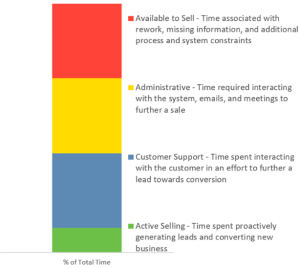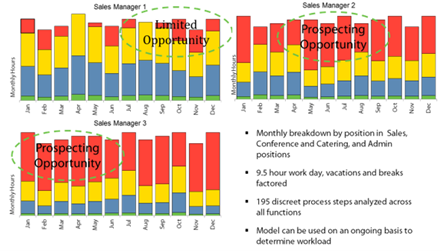Hotel owners and operators have been looking up and down their organizations for opportunities to not only be more efficient with their employees’ time but to also challenge past operational practices – yet, how much change has actually taken place? One area that change is both due and fit to be reimagined is the classic approach to a hotel’s sales department – particularly: group, small meetings, and event booking teams.
In the month’s leading into the pandemic, hotel sales teams were routinely setting year-over-year records as demand continued to steadily increase. However, now 18-months later, the environment has drastically changed. The need to attract and capture the supply of business that is available has never been more competitive. But why rely on traditional organizational structures and methods to win a piece of business?
In this two-part series, we will examine a few of the opportunities that have stood out to us as we have analyzed the structure and strategies of hotel sales departments over the last decade. While the opportunities have persisted for some time, the pandemic has created the reasonable impetus to explore adjustments to the status quo.
Prospect, Prospect, Prospect
What may seem obvious today now that in-bound lead volumes have become reduced, prospecting has long been a largely absent routine from hotel sales departments. The concept of prospecting can take on many forms and should not be limited to the old days of awkward and unrewarding lists of clients to cold call. In numerous studies, across numerous properties and brands, Carpedia Hospitality’s project teams have found that the time spent active selling – prospecting – to be almost non-existent.

Regardless of the shape or form that your sales department takes on – which will be discussed in the second part of this series – establishing the roles and responsibilities that include and reward activities related to active selling should be considered with an increased priority. So how should you get started?
Traditionally, the volume of in-bound requests has represented the majority of lead volume for sales managers, and for that reason, should not be ignored. Understanding the amount, quality, time to process, and how this type of volume flows throughout the year are all important factors when considering what available time exists in order to increase your department’s active selling time. What’s more, as demonstrated in the graph above, administration and customer support make up just shy of two-thirds of the average sellers observed time. Analyzing and challenging the activities that fall into these categories should also be considered when aiming to define active selling expectations.
Establishing a prospecting plan will need to be more nuanced and customized than simply inserting an expectation. Rather a more holistic review of the seller’s market or territory’s annual sales cycle will assist in defining opportunities to appropriately embed this activity.

From there, lead lists and networking opportunities should be generated and scrutinized for quality, both in terms of the nature of the lead’s profile but also the accuracy of biographical information. As sellers are largely motivated by converting leads to business, rewards and compensation must be aligned to the rebalanced sales strategy that reinforces both proactive and reactive selling.
Manage your Conversions
In the second part of this series, we will explore how best to align sales activities to the larger organizational-wide operating system in order to ensure optimum performance and sustainability; however, to do so effectively, a fundamental appreciation for the importance of managing the conversion rates of a lead through each stage of the sales funnel is an important behavioral and quantitative routine to influence the sales processes.
While there is rarely disagreement with that notion, in our project work, across locations and brands, it has been rare for sales managers to either have conversion-level goals or visibility and knowledge to their attainment. As such, both sales managers and their leaders have struggled to articulate with specificity their current state, backlog, or need for support at a point in the sales process that is persistently acting as a constraint. The resulting affect is that opportunities for improvement go largely unnoticed until they are too late to impact.
At end of the day, we all like to go home with an understanding of whether we are on track or not. Knowing whether it has been a good day or bad day can provide the context and motivation necessary to continuously improve performance.
“You can’t manage what you can’t see”
A few years back during one of our project team’s weekly update meetings, an engaged client proclaimed with efficiency what our consultant team had been attempting to articulate with many more words – “you can’t manage what you can’t see”. While this client was particularly interested in reviewing a specific result, the statement fundamentally rings true for one of the bedrock attributes Carpedia Hospitality brings to our clients – visibility.
For example, when those same sales managers who were not previously able to articulate their conversion rates were provided real-time visibility to their funnel, along with a customized prospecting tool, their ownership of the quantity and quality of leads in their funnel and their ability to articulate gaps or challenges almost instantly increased.
Each of these concepts and prescriptions for improvement likely seem both obvious and attainable, yet observing and analyzing the construct and interactions of a particular workstream or department is generally not completed as well when left for self-evaluation. Similarly, it is rare that there is a sufficient workload available to warrant internal resources being dedicated to completing such an evaluation or have a sufficient mandate to impartially construct effective findings and implement changes amongst competing organizational priorities.
It is for these reasons that owners and operators, alike, turn to groups like ours to generate an external vantage to review routine processes.
The graphs above seem sufficiently simple and illustrative enough to simultaneously dictate and be the impetus for change. Yet arriving at that stage and then subsequently designing the necessary installation roadmap, along with the tools to measure the successes (or variances) is often the differentiator between sustaining the initiative or falling to the prevailing headwinds that is the status quo.
Obtaining visibility to results is fundamental for continuous improvement. In the second part of this two-part series, we will explore some of the methods we use when optimizing the structure of hotel sales teams and how best to ensure there is effective alignment between sales efforts and the necessary required results of the broader organization.
While it has become cliché to say, the pandemic has afforded the hospitality industry the opportunity to reimagine routine structures and processes. Effectively using this period integrate a regime of “smart prospecting” into your sales team will both assist to accelerate current performance and heighten your team’s engagement.
Continue reading to learn more about how our methodology can offer some insight towards answering the question: Is your Sales Department Designed for the Post-Pandemic Environment?